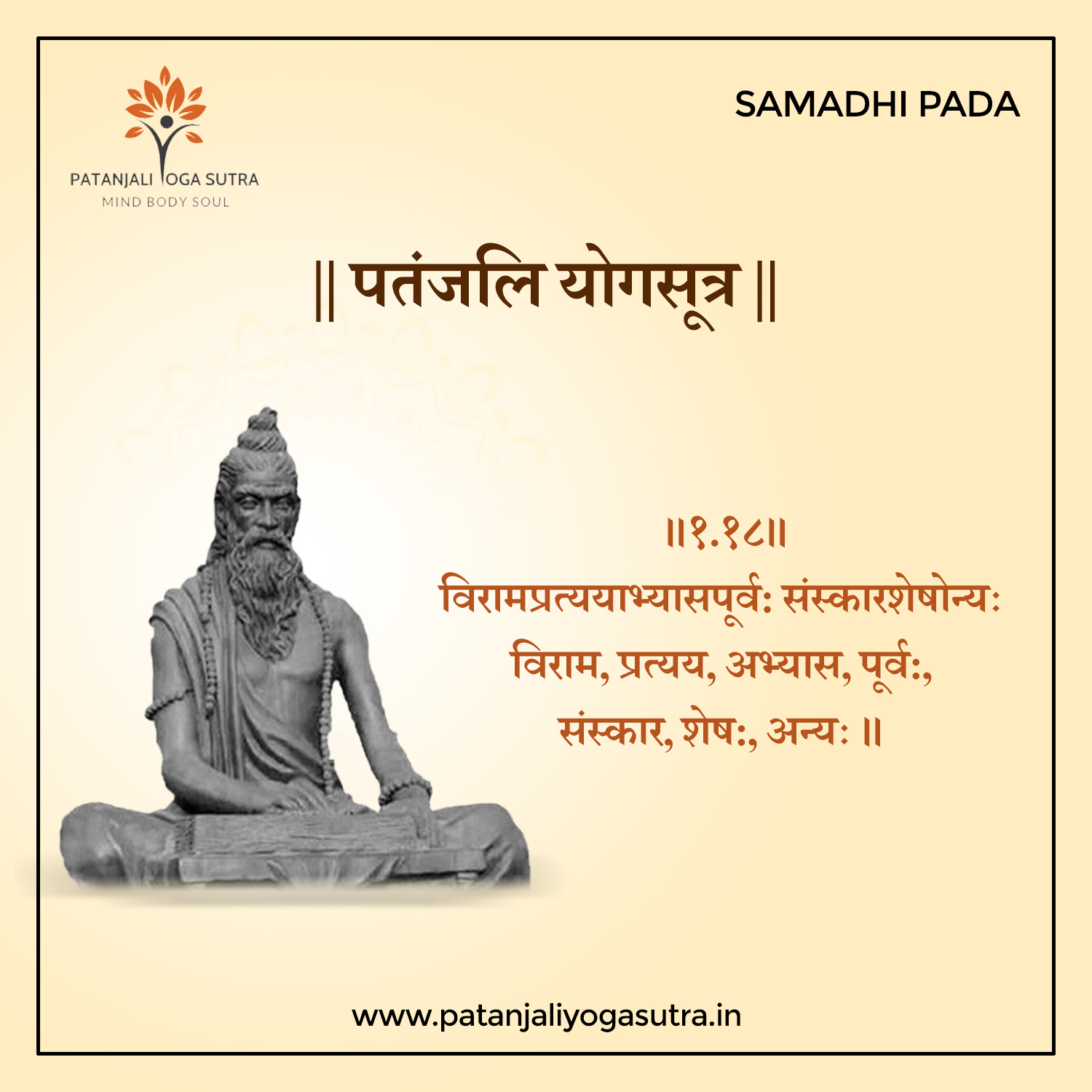



सम्प्रज्ञात समाधि के अवांतर भेदों को ठीक ठीक समझकर शिष्य महर्षि से पूछते हैं कि अब हमें असम्प्रज्ञात समाधि के लिए विषय में बताईये | वह कैसे साधक को प्राप्त होती है और उसके लिए किन साधनों, उपायों से प्राप्त किया जा सकता है ?
महर्षि पतंजलि कहते हैं कि जब सब प्रकार की वृत्तियों (विचारों) का निरोध हो जाता है अथवा सब विचार रुक जाते हैं और जिस उपाय या साधन (पर वैराग्य) से वह स्थिति साधक को प्राप्त होती है, जब साधक उसका बार बार अभ्यास या आवृत्ति करता है तो उसके बाद जो केवल संस्कार शेष बचते हैं वह स्थिति सम्प्रज्ञात समाधि से अलग “असम्प्रज्ञात समाधि की होती है”।
आईये इसे ठीक से समझते हैं- एक साधक योग के अनुष्ठान यम, नियम आसन, प्राणायाम, प्रत्याहार, धारणा, ध्यान और समाधि रूप इस अष्टांग योग को अत्यंत श्रद्धा पूर्वक साधना कर रहा है। योग के स्वरूप का उसको अच्छे से सैद्धान्तिक ज्ञान है। वह वृत्तियों के पांच रूपों को भी जानता है और क्लिष्ट अक्लिष्ट भेद से जीवन में क्लिष्ट वृत्तियों को रोकने की भी साधना साथ साथ करता है।
वह यह भी जानता है कि ये पांच प्रकार की क्लिष्ट वृत्तियाँ उसके साधना मार्ग की प्रमुख बाधाएं हैं और निरंतर अभ्यास और वैराग्य से वह इन्हें समाप्त कर सकता है, ऐसा उसे पूर्ण विश्वास है। समाधि के दो भेद सम्प्रज्ञात और असम्प्रज्ञात हैं यह जानते हुए वह वितर्क, विचार, आनंद और अस्मिता के क्रम से सम्प्रज्ञात समाधि का अनुभव करता है।
जब तीव्र साधना करते करते हुए, पर वैराग्य का बार बार अभ्यास करते हुए और अभ्यास की भी बारंबार आवृत्ति करते हुए एक ऐसी स्थिति में पहुंच जाता है जब उसके मन से सब प्रकार के विचार कुछ समय के लिए समाप्त हो जाते हैं तो उस स्थिति को ही असम्प्रज्ञात समाधि कहते हैं। लेकिन इस स्थिति में कुछ संस्कार शेष रह जाते हैं उन्हें हम निरोध के संस्कार कहते हैं अर्थात रोकने के संस्कार। थोड़े समय के बाद जैसे ही किसी साधक की असम्प्रज्ञात समाधि खंडित होती है तो उसे स्मरण आता है कि वह एक ऐसी स्थिति में था जहां सबकुछ शून्य सा हो गया था, कोई विचार नहीं था बस एक अनुभूति थी। यह जो अनुभव है वह बिना संस्कार और संस्कार जन्य स्मृति के बिना नहीं हो सकता था। अतः समाधि के समय जो शून्यता का संस्कार है वह शेष रह जाता है। इसलिए सब प्रकार के विचार रुक जाने के बाद केवल संस्कार शेष की स्थिति को ही “असम्प्रज्ञात समाधि” कहते हैं।
After a sound understanding of advanced types of Sampragyat Samadhi, the disciples ask Maharshi, about the ways and means through which a meditator can attain Asampragyat Samadhi.
Maharshi explains that after reaching a stage where the practitioner controls all modifications and with continuous practice experiences a complete stillness of mind with no thoughts arising, then he is left only with mental impressions. That stage is Asampragyat Samadhi which is different from Sampragyat Samadhi.
Let’s understand it well – A practitioner practices all ceremonial eight limbs, Yama, Niyama, Pranayama, Pratyahara, Dharana, Dhyana and Samadhi, of yoga with reverence. He has good theoretical knowledge of Yoga and is aware of five kinds of modifications too. Realizing the difference between kalisht and akalisht vritties he practices to prevent kalisht vritties.
He also knows that these five types of modifications are the main roadblocks in his meditation path and he firmly believes that these can be removed with constant practice and detachment. Sampragyat and Asampragyat are the two types of Samadhi. Knowing this he experiences Sampragyat Samadhi following the order of reasoning, deliberation, bliss and ego.
With constant practice of intense meditation and frequent detachment he reaches the stage of Asampragyat Samadhi, where his mind becomes quiet and does not get any thoughts. In this stage only some sanskaras, known as nirudh sansakaras remain. After some time when the practitioner’s Asampragyat Samadhi is destroyed he remembers that he was in a stage of complete withdrawal from sense objects with no thoughts but a feeling. This feeling or experience cannot be felt without sanskara or its memory. Thus, in the state of Samadhi the sanskara of complete emptiness is left. Therefore, after preventing all kinds of thoughts the state of empty mind sansakaras is called Asampragyat Samadhi.
सूत्र: विरामप्रत्ययाभ्यासपूर्व: संस्कारशेषोSन्यः
साधना के पथ पर आगे बढ़ता योगी
अभ्यास और वैराग्य उसके बनते सहयोगी
अकलिष्ट विचारों पर नकेल है कसता
वैराग्य से अनासक्त स्वभाव में रहता
चित्त साफ स्वच्छ होने लगता है
सब संस्कार वह खोने लगता है
जब शेष निरोध के संस्कार बचते हैं
उसे असंप्रज्ञात व्यवहार कहते हैं।
अहा! अद्भुद अविस्मरणीय व्याख्या। “पूज्य श्री” को अनन्य प्रणाम ।
Like!! Really appreciate you sharing this blog post.Really thank you! Keep writing.